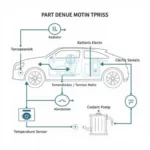The dreaded check engine light can strike fear into the heart of any car owner. When your vehicle throws the OBD2 code P2004, it signals a problem with the intake manifold runner control circuit, specifically on Bank 1. Don’t panic! Understanding this code and its implications can help you take the right steps towards getting your car back on the road.
This comprehensive guide dives deep into the P2004 code, explaining its causes, symptoms, diagnostic procedures, and potential solutions.
What Does the P2004 Code Mean?
Your car’s engine is a complex system optimized for performance and fuel efficiency. A key component of this system is the intake manifold, responsible for distributing air to the engine cylinders. Inside the intake manifold, you’ll find intake manifold runners, which are flaps that control the airflow.
The intake manifold runner control (IMRC) system, using these flaps, optimizes airflow at different engine speeds. At lower RPMs, the IMRC system partially closes the runners, increasing air velocity for improved low-end torque. At higher RPMs, the runners open fully, allowing maximum airflow for increased horsepower.
The P2004 code specifically indicates a problem with the electrical circuit controlling the intake manifold runner control solenoid for Bank 1. “Bank 1” refers to the side of the engine containing cylinder #1. This malfunction disrupts the IMRC system’s ability to adjust airflow properly, impacting engine performance and potentially triggering the check engine light.
Common Symptoms of a P2004 Code
While the illuminated check engine light is the most obvious sign, several other symptoms might indicate a P2004 code:
- Reduced Engine Performance: You might notice a decrease in power, especially at low RPMs, due to the incorrect airflow caused by the faulty IMRC system.
- Rough Idle: When idling, the engine might vibrate excessively or sound rough as the air-fuel mixture becomes imbalanced.
- Hesitation or Stalling: Problems with the IMRC system can cause the engine to hesitate during acceleration or even stall unexpectedly.
- Poor Fuel Economy: Because the engine isn’t receiving the optimal air-fuel mixture, fuel consumption can increase.
What Causes a P2004 Code?
Several culprits can trigger the P2004 code, ranging from simple electrical issues to more complex mechanical problems.
- Faulty IMRC Solenoid: This solenoid controls the vacuum or electrical signal that operates the intake manifold runners. If it fails, it disrupts the entire system.
- Vacuum Leaks: The IMRC system often relies on vacuum pressure to operate. Leaks in the vacuum lines or the intake manifold itself can prevent proper runner control.
- Wiring Problems: Damaged, corroded, or loose wiring in the IMRC circuit can interrupt the electrical signals, leading to malfunctions.
- Carbon Buildup: Over time, carbon deposits can accumulate on the intake manifold runners, restricting their movement and hindering proper operation.
- Faulty IMRC Actuator: The actuator physically moves the intake runners. If it fails, the runners won’t be able to adjust correctly.
Diagnosing the P2004 Code
Accurately diagnosing the root cause of the P2004 code requires a systematic approach:
- Read the Code: Connect an OBD2 scanner to your vehicle’s diagnostic port and retrieve any stored codes. Note all codes present, as multiple codes can offer additional clues.
- Inspect the IMRC Solenoid: Locate the IMRC solenoid and visually inspect it for any signs of damage, corrosion, or loose connections. Check the wiring harness for any breaks or fraying.
- Check for Vacuum Leaks: With the engine running, listen for any hissing sounds that could indicate a vacuum leak. You can also use a carburetor cleaner spray around potential leak points while monitoring the engine’s RPM for changes.
- Test the IMRC Actuator: Depending on your vehicle’s make and model, you can apply vacuum or voltage directly to the IMRC actuator to verify its operation.
- Inspect for Carbon Buildup: In some cases, removing the intake manifold to visually inspect the runners for carbon buildup might be necessary.
How to Fix a P2004 Code
The specific repair for a P2004 code depends on the underlying cause identified during the diagnostic process.
- Replace Faulty Components: If you’ve diagnosed a faulty IMRC solenoid, actuator, or wiring harness, replacing these components is typically the solution.
- Repair Vacuum Leaks: Seal any leaks found in the vacuum lines, intake manifold, or related components.
- Clean Carbon Buildup: For carbon buildup issues, cleaning the intake manifold runners and related components can restore proper airflow. In some cases, using a fuel additive designed to clean intake deposits might suffice.
- Seek Professional Help: If you’re uncomfortable performing these repairs or if the issue persists, consult with a qualified mechanic experienced in OBD2 diagnostics and repairs.
Expert Insights
[Insert Name of Fictitious Expert], ASE Certified Master Technician, emphasizes, “While the P2004 code can be straightforward, it’s crucial not to jump to conclusions. Thoroughly inspecting all potential causes ensures you address the root of the problem and avoid unnecessary repairs.”
P2004 Code: FAQs
Q: Can I still drive with a P2004 code?
A: While driving short distances with a P2004 code might be possible, it’s not recommended. Continued driving can worsen the underlying issue and potentially lead to more severe engine problems.
Q: How much does it cost to fix code P2004?
A: Repair costs vary depending on the root cause and labor rates. Simple repairs like replacing a faulty IMRC solenoid can be relatively inexpensive, while more complex issues requiring intake manifold removal can be significantly pricier.
Need More Help?
Understanding your car’s OBD2 codes empowers you to address engine issues proactively. If you’re facing the P2004 code or any other car troubles, don’t hesitate to reach out for expert guidance. Our team at OBDFree is here to help! Contact us via WhatsApp at +1(641)206-8880 or email us at [email protected] for 24/7 support and get your car back in top shape.


